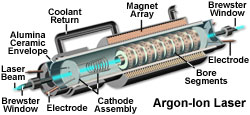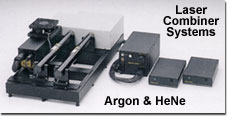 |
 |
 |
|
||||||||||||||||||||||||
 | ||||||||||||||||||||||||
 | ||||||||||||||||||||||||
 | ||||||||||||||||||||||||
Illumination System Components

The Olympus FluoViewTM confocal microscopes can be configured with several different types of laser combiners and other illumination system components.
The FluoViewTM confocal microscopes can be equipped with a variety of laser systems in several different configurations. Among the lasers available for this instrument are the traditional argon-ion and helium-neon, as well as argon-krypton, helium-cadmium, and blue diode lasers. Olympus confocal microscopes can also be adapted to tungsten-halogen and arc-discharge lamps for simultaneous imaging in fluorescence, confocal, and brightfield enhanced contrast techniques (including differential interference contrast). The transmitted light images, while non-confocal, are very useful when superimposed to the confocal image.
Laser Systems Offer Large Selection of Wavelengths

Laser systems designed for the Olympus FluoViewTM confocal microscopes have a broad spectrum of available wavelengths with intensities selectable by individual neutral density filters or the acousto-optic tunable filter (AOTF) controller for simultaneous or automated-sequential collection of multi-channel images. A choice of the 440-nanometer diode laser and the 442-nanometer helium-cadmium laser is available for fluorescent protein (cyan and yellow, CFP/YFP) resonance energy transfer applications, providing optimal excitation of CFP and spectral separation from the YFP. The shutters and light intensity can be controlled via the system computer.
Available Lasers and Spectral Lines
- Blue argon-ion (488 nanometers) laser
- Multi-line argon-ion (457, 488, and 514 nanometers) laser
- Green helium-neon (543 nanometers) laser
- Red helium-neon (633 nanometers) laser
- Yellow krypton-ion (568 nanometers) laser
- Blue-violet helium-cadmium (442 nanometers) laser
- Violet and blue-violet diode (405 and 440 nanometers) lasers
- Ultraviolet argon-ion (351 nanometers) laser
- Infrared (750 nanometers) laser


Additional laser ports are available on the FV500 for optimal imaging with ultraviolet and infrared lasers. The 405-nanometer diode laser, a low cost alternative to water-cooled ultraviolet lasers, can be used for most ultraviolet imaging applications, including nuclear imaging with DAPI. Unique laser modulation of the 405-nanometer diode laser permits high-speed control of the light intensity, which can be important for photoactivation and photobleaching studies. The exceptional light stability of the 405-nanometer diode laser is also important for time-lapse studies of living cells.
Tungsten-Halogen and Arc-Discharge Illumination

An external transmitted light detector system and fluorescence illumination system are available as auxiliary components for the FluoViewTM confocal microscopes. The former consists of an external photomultiplier for transmitted light detection and transmitted light illumination, both adapted to the microscope frame via a dual fiber system. The fluorescence illuminator utilizes a fiber optics light guide and beam expander to fill the objective rear aperture with even illumination across the entire ultraviolet, visible, and infrared spectral regions.
